Please use this identifier to cite or link to this item:
https://repositorio.ipea.gov.br/handle/11058/15379Files in This Item:
| File | Description | Size | Format | |
|---|---|---|---|---|
| en_IPCOnePager18.pdf | 39.53 kB | Adobe PDF |  View/Open | |
| es_IPCOnePager18.pdf | 62.88 kB | Adobe PDF |  View/Open | |
| fr_IPCOnePager18.pdf | 66.33 kB | Adobe PDF |  View/Open | |
| pt-br_IPCOnePager18.pdf | 65.48 kB | Adobe PDF |  View/Open |
| Title: | Headcount Poverty Comparisons |
| Other Titles: | Comparaciones de Índices de Pobreza Comparaison des effectifs de la pauvreté Comparações da Pobreza pelo Índice de Incidência da Pobreza |
| Authors: | Subramanian, S. |
| Abstract: | The most elementary, and also the most widely employed, means of assessing the extent of poverty in any society is to obtain a simple headcount of the poor. The poor are those whose incomes fall short of a stipulated poverty line. The commonest measure of poverty is the headcount ratio, H, which is the proportion of the poor in the total population. An alternative, and far less routinely used headcount index, is the aggregate headcount, A, which is the total absolute number of the poor. A problem for the measurement of poverty – and one which is only rarely acknowledged by professional economists – is that the headcount ratio and the aggregate headcount can provide contrary poverty rankings. For example, if in some initial time period 30 persons in a population of 100 are poor, while in a later time period 40 persons in a population of 200 are poor, then the headcount ratio declines from 30 per cent to 20 per cent, whereas the aggregate headcount rises from 30 persons to 40 persons. This type of problem is often encountered. For example, using a poverty line of 2.15 Purchasing Power Parity dollars per person per day, the global headcount ratio has been estimated to have declined from 66.7 per cent in 1981 to 52.9 per cent in 1991, while over the same period, the global aggregate headcount has been estimated to have risen from 2,450 million to 2,735 million. (...) O mais elementar, e também o mais amplamente empregado, meio de avaliar a dimensão da pobreza |
| metadata.dc.rights.holder: | International Policy Centre for Inclusive Growth United Nations Development Programme |
| metadata.dc.rights.license: | O texto e dados desta publicação podem ser reproduzidos desde que as fontes sejam citadas. Reproduções com fins comerciais são proibidas. |
| metadata.dc.type: | One Pager |
| Appears in Collections: | Publicações do IPC-IG |
Items in DSpace are protected by copyright, with all rights reserved, unless otherwise indicated.

